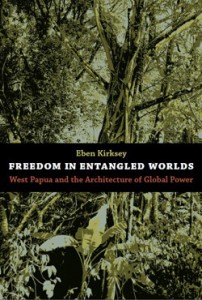“From July 2 to July 6, 1998, when the military opened fire, the morning star flag flew over the thirty-five-meter-tall water tower near the harbor in Biak town. (Biak is the name of the island, the district, and the district capital.) The demonstration was led by a Jayapura-based provincial government employee named Filip Yopy Karma…The flag appeared on the top of the tower on July 2, at about 5:00 a.m. Some seventy-five people gathered beneath it, shouting freedom slogans, singing songs and dancing traditional dances. Some had painted their faces and arms with the morning star symbol, and as the demonstration continued, many people in the immediate area joined in. The water tower is near both the main taxi terminal and a major market, so the site is one that many people would pass as part of their daily lives. Small boys reportedly guarded the area wearing armbands that said “Satgas [task force] OPM.” The demonstration grew to more than 500 people by one account” (Human Rights Watch 1998: 6).
“At 1:00 a.m. on July 4, the local military brought nine village heads together to discuss a strategy for attack, and both the subdistrict head (camat) and the subdistrict military commander told the village heads that each man was responsible for bringing thirty men into the city. He also told them that the district commander’s instructions were that each man should bring a weapon of some sort, whether a spear, a knife, or some other sharp object” (1998: 8).
“The long-awaited attack took place at 5:00 a.m. on July 6. Troops from Battalion 733 Pattimura, stationed at the air force base at Manuhua aided local forces, and were reinforced by troops from two warships…The troops opened fire from four sides. Witnesses reported that five civilians who were already on the ground prone were deliberately shot. By 9:00 a.m., twenty-one people had been brought to the hospital, one of whom, Ruben Orboi, died about an hour later in the hospital’s emergency room; he had been shot in the head. A month later, his body had still not been turned over to his family” (1998: 9).
“In the meantime, thirty-three bodies of men, women, and children washed up on the shore of East and North Biak beginning on July 27. The Indonesian army claimed they were victims of the tsunami that struck Aitepe, Papua New Guinea on July 16. There were unconfirmed reports from local people that some of the bodies had their hands tied behind their backs, and one was wearing a Golkar T-shirt, giving rise to the belief that at least some of the bodies might be those of shooting victims… Six bodies, including an adult male, three adult females, an adolescent girl, and a girl estimated to be about four years old, were found in East Biak on July 27 and immediately buried by security forces. The bodies were in poor condition, but police said that some were marked with a tattoo that resembled the letter W.
Nine more bodies washed up the next day. Of the six found in Amini village, five were children (three boys and two girls), and one was an adult woman wearing a shell necklace. A body of a girl estimated to be about twelve years old was found in Nyampun, Orwer village, and two other headless bodies were found on Paidado island, near the villages of Pasi and Saribra…On July 29, the body of an adult male was found in Yobdi, North Biak, and that of a young girl was found near Wadibu, East Biak” (1998: 10).
“For the full text of this report, see The Human Rights Watch Report
BOOK: Freedom in Entangled Words
Eben Kirksey arrived in Biak harbor on July 5th, 1998, the day before the attack. He was then an exchange student at Bird of Paradise University (UNCEN) and was traveling through Biak on his way to conduct anthropological research in the highlands. Waylaid in Biak for several days, he talked with many of the protesters who were gathered under the water tower and took pictures of the Navy ships that dumped people at sea. Later, as a graduate student at the University of Oxford, Kirksey returned to Biak to interview key survivors of the massacre. His book, Freedom in Entangled Worlds, contains passages from his personal journal and reports on his findings:
Sunday, 5 July 1998, 7:00 AM
Our ship has just docked in the Biak harbor and outside there is a crowd chanting “Papua merdeka!” (Free Papua!) The Morning Star flag is flying on a nearby water tower. As soon as the ship docked several young men boarded and ran around the ship waving banners and shouting. Other passengers are saying that these men are now asking for money. My newfound friend and traveling companion, the Belgian entomologist, appears to be the only other foreigner on the passenger ship. The harbor is devoid of any Indonesian government authorities. These youths have reportedly been occupying the harbor for the last several days. My connecting ferry to Nabire is no where in sight…
Read more for free on Google Books or purchase a copy on Amazon.com







2 comments
Cerpen Biak Berdarah Kesaksian Filep Karma: dari Kejadian yang Mirip Film Perang, Pembersihan oleh Tentara, sampai Putusan Aneh Mahkamah Agung – Situs Berita Tolikara No. 1 says:
Oct 23, 2018
[…] https://medium.com/media/93bf8cf1ef532e8701f88b87bca274da?postId=d47566cf1f56 sumber: https://www.biak-tribunal.org/biak-massacre-trailer/ […]
nagagold88 says:
Jun 9, 2024
This design is wicked! You definitely know how to keep a
reader entertained. Between your wit and your videos, I was
almost moved to start my own blog (well, almost…HaHa!) Excellent job.
I really loved what you had to say, and more than that,
how you presented it. Too cool!